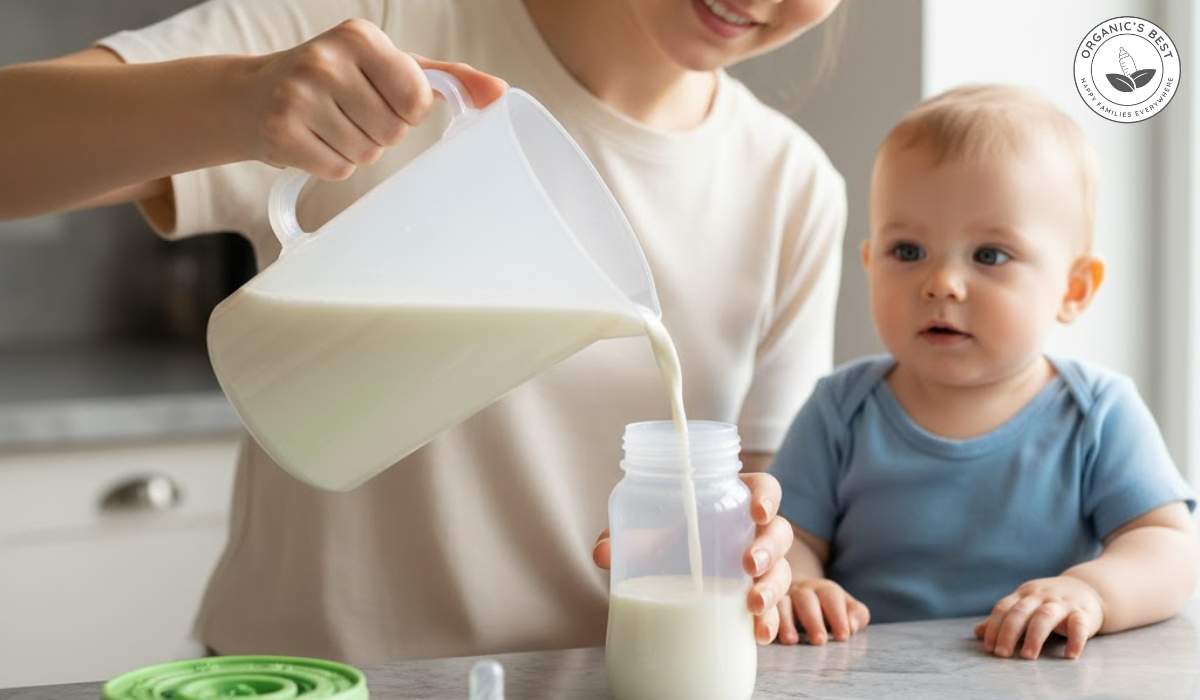Click to Get 2 FREE Boxes/Cans
Click to Get 2 FREE Boxes/Cans
Only New Customers! Click HERE to Get 2 Extra Boxes/Cans for Free With Your First Order.
Only New Customers! Click HERE to Get 2 Extra Boxes/Cans for Free With Your First Order.
BABY FORMULA
Offering new parents top-quality European infant formula from renowned brands like HiPP, Holle, Kendamil, and more. If you’re uncertain about which product to choose, our Formula Finder can help you make the best decision for your baby.
Baby Food
Offering new parents a premium selection of European baby foods, including jars, pouches, cereals, and snacks from esteemed brands like HiPP and Holle.
Understanding Stages of Breast Milk: Colostrum, Transitional Milk, Mature Milk
by Agustina Fernandez April 29, 2025 8 min read

Breast milk has a strong reputation as nature's most powerful nourishment and is often referred to as "liquid gold". As the nickname suggests, it's more than just food; it's a dynamic source of strength, vitality, and protection, perfectly tailored to support a baby's growth and development from the moment they enter the world.
What makes breast milk truly extraordinary is its ability to evolve. It's not a static substance. Instead, it changes in composition to meet the ever-changing needs of infants, day by day and feed by feed.
Many moms look forward to the bonding and benefits that come with breastfeeding, but it's important to remember that it's not always a realistic path for everyone. When it comes to feeding your baby, there's no one-size-fits-all approach, and there are many nourishing options to satiate rumbling little bellies.
That said, today we're shining the spotlight on breast milk, nature's original superfood. Below, you'll read about some of the incredible ways it supports your baby's development and how it evolves through each stage of early life.
Table of Contents
Introduction to Breast Milk
Most babies start feeding as early as just one hour after birth. There's even a term for this time called the "Magic Hour" or "Golden Hour", where little ones are extra alert and responsive to breastfeeding. This is where the breastfeeding journey begins for many mothers.

Breast milk is a remarkable, nutrient-dense fluid created by the mammary glands to nourish and protect infants from the very start of life. Designed by nature to meet every need of a growing baby, it contains the perfect balance of proteins, fats, carbohydrates, vitamins, and minerals essential for healthy development.
Breast milk production begins naturally during pregnancy, usually around the 16th week, as the milk ducts begin to grow in size. This growth is driven by hormonal changes that prepare the body for feeding. Once the baby is born, this process is further stimulated by skin-to-skin contact and the act of nursing or pumping.
In the first few days after birth, the breasts produce a thick, golden-yellow milk known as colostrum. Often referred to as a baby's first vaccine, colostrum is packed with immune cells, antibodies, and protective factors that help build a newborn's immune system and lay the foundation for lifelong health. From there, the breast milk journey continues.
Breast Milk Color Chart: Stage by Stage Changes
Breast milk goes through phases during the first few days of production. It begins with colostrum, then shifts into the transitional phase, and finally becomes mature milk, which continues to nourish your baby for the rest of the breastfeeding journey. To break it down even further, there are two types of mature milk called foremilk and hindmilk.
The breast milk stages each come with a purpose and act as a beautiful reminder of just how in tune a mother's body is with their baby's needs.
We'll walk through each stage below, and trust us, you'll be amazed by what a woman's body can do!
If you're breastfeeding or planning to, this chart is a helpful guide, providing insight into the three stages of breast milk production.

Human Colostrum and First Milk: What is Colostrum?
Colostrum is the very first milk produced. It shows up during pregnancy and sticks around for the first few days after birth.
Even though it comes in small amounts (we're talking teaspoons, not bottles), it's loaded with powerful stuff: protein, antibodies, and immune-boosting goodness that helps protect your baby from germs while their own immune system is still figuring things out.
It's thicker than regular breast milk, more yellowish, and packed with purpose. After around day 3 or so, your milk starts to change, signalling the end of colostrum production.
When Does Colostrum Come in?
Bodies start making colostrum before the baby is even born! It usually starts showing up sometime in the third trimester, though it may not be noticeable until the breast starts leaking. After birth, colostrum is ready and waiting, often becoming baby's first "meal" during those cozy skin-to-skin moments right after delivery.
What Does Colostrum Look Like?
If you're expecting milk to look, well, milky, colostrum might throw you off at first. The colostrum color is usually golden or yellowish, and the texture is thicker than what you might expect, hence its other common name, "liquid gold". Some parents say it looks a bit like melted butter or even maple syrup. However, every body is different, so the thickness and colour vary from person to person.
Colostrum Benefits for Baby
There are a ton of colostrum milk benefits. Think of colostrum as a baby's first immunity shield. It's full of antibodies, especially one called secretory IgA, which coats and protects a little one's delicate gut, helping block out harmful bacteria and viruses. It also helps babies pass their first poop (meconium), which clears out waste and reduces the risk of jaundice.
And the best part? Even the tiniest drop is powerful. So whether you're nursing, hand-expressing, or pumping, every bit of colostrum counts.
Transitional Milk
After colostrum, breast milk comes the next phase, transitional breast milk. This is the bridge between colostrum and mature milk. It typically appears a few days after birth, as the body begins producing larger volumes of milk to meet a newborn's increasing feeding needs.
Mothers often notice physical signs when transitional breastmilk arrives, such as breast fullness or slight tenderness, which are common indicators that the milk supply is increasing.
What Does Transitional Milk Look Like?
The transitional milk color is usually creamier and lighter compared to colostrum. While it often appears white or slightly yellow, it can also have a bluish tint depending on the time of day or how much milk is stored in the breast. Though thinner than colostrum, it remains nutrient-dense and continues to provide important immune support for the baby.
When Does Transitional Milk Come in?
Most mothers begin producing transitional breastmilk around 3 to 6 days postpartum, although this timeline can vary slightly depending on factors such as the birth experience, how often the baby is feeding, and whether the mother has breastfed before.
Transitional breastmilk typically lasts for about 10 to 14 days before the body fully transitions to mature milk.
Transitional Milk Benefits for Baby
Transitional breastmilk supports the baby's rapid development in the early weeks. It contains more fat, lactose, and calories than colostrum, helping to satisfy a growing appetite and support steady weight gain. At the same time, it still provides immune protection as the baby's digestive and immune systems continue to mature.
Colostrum vs Transitional Milk
Colostrum and transitional breastmilk each serve a unique purpose in a newborn's early life. Colostrum is the baby's first milk, thick, golden, and rich in antibodies that offer critical immune protection. Transitional breastmilk follows shortly after, increasing in quantity and caloric content to support growth while still delivering some of those early protective benefits. Together, they lay the foundation for healthy feeding and development in the first weeks of life.
Mature Milk
Around 2 to 4 weeks after birth, breast milk reaches its final stage: mature breast milk. This is the milk that continues to nourish the baby for months to come, and it's perfectly adapted to support steady growth, brain development, and immune protection.
This milk isn't just food, it's fuel, hydration, immune support, and comfort all in one.
Foremilk and Hindmilk

-
Foremilk is the milk that comes out first. It's more watery and higher in lactose (a natural milk sugar), which helps to quench baby's thirst and provide a quick energy boost. It's also lower in fat compared to what comes later.
-
Hindmilk follows as the feeding continues. This milk is richer, creamier, and higher in fat, offering the long-lasting calories that help babies stay full, gain weight, and support brain development.
Because this shift happens gradually, there's no hard line between foremilk and hindmilk, and there's no need to time feeds or track which type of milk your baby is getting.
In most cases, babies naturally get what they need by feeding for as long as they want on one breast before switching sides.
However, if a baby consistently receives mostly foremilk, due to switching breasts too quickly or feeding in very short sessions, they may experience some mild digestive discomfort.
Signs of too much foremilk can include gas, fussiness, or green, frothy stools, which stem from the higher lactose content being digested without the balancing fat from hindmilk. Babies may also seem hungrier sooner, since foremilk alone isn't as satiating.
To help ensure a good balance, many lactation experts recommend allowing the baby to fully drain one breast before offering the other. This simple approach helps babies get the full nutritional range of breast milk, hydration at the start, and healthy fats as the feeding progresses, without needing to overthink timing or volume.
When Does Mature Milk Come in?
Mature breast milk usually comes in between weeks 2 and 4 postpartum, gradually replacing transitional breastmilk. For most mothers, the change is subtle, but behind the scenes, the milk is evolving to keep up with baby's rapidly growing brain, body, and immune system.
What Does Mature Milk Look Like?
The mature milk color is typically lighter and thinner in consistency compared to the earlier stages. It may appear white, slightly bluish, or even yellowish, depending on factors like time of day, how full the breasts are, and individual biology. Despite looking more watery than colostrum, it's densely packed with nutrients.
Fun fact: Mature breast milk is made up of about 87% water, so it hydrates and nourishes at the same time. However, it's important to be aware that all phases of breast milk and baby formula satisfy babies' hydration needs completely until 6 months of age, when small amounts of water can begin to be introduced.
Mature Milk Benefits for Baby
Mature breastmilk is a complete source of nutrition. It contains:
-
Healthy fats for brain and nervous system development
-
Carbohydrates and proteins for energy and growth
-
Vitamins and minerals to support everything from bones to eyesight
-
Ongoing immune protection, including live antibodies
Transitional Milk vs Mature Milk
While transitional breast milk bridges the gap between colostrum vs milk that's mature, the mature phase provides long-term nourishment. Transitional breast milk still carries some early protective qualities and tends to be higher in certain proteins.
Mature breast milk, in contrast, is more balanced in fat and calories, designed to sustain the baby's growth and energy needs over time.
Answering Your Additional Questions
Let's go over some of the most common questions about the different stages of breast milk, because if it's on your mind, chances are other breastfeeding parents are wondering the same thing.
How Much Colostrum Does a Newborn Need?
Not very much since newborns have very small stomachs at birth, about the size of a marble. In the first few days, just 1-2 teaspoons of colostrum per feeding is typically enough. Despite the small volume, colostrum is incredibly concentrated, providing all the nutrients and immune protection your baby needs during this early stage.
Is it Okay to Squeeze out Colostrum?
Yes, expressing colostrum, either by hand or with a pump, is perfectly safe and often recommended by lactation specialists. This can be helpful if your baby is having difficulty latching or if you're preparing for delivery and want to have a small amount stored in advance. Hand expression tends to be most effective, especially in the early days.
When Does Colostrum Turn into Milk?
Colostrum is milk, but it gradually transitions into what's known as transitional human milk around days 2 to 5 postpartum. During this time, milk volume increases, and you may notice changes in color and consistency. By approximately 2 to 4 weeks after birth, mature milk is fully established, tailored to meet your baby's ongoing nutritional needs.
|
Disclaimer: Please be aware that this information is based on general trends in babies, and it is not medical advice. Your doctor should be your first source of information and advice when considering any changes to your child’s formula and when choosing your child’s formula. Always consult your pediatrician before making any decisions about your child’s diet or if you notice any changes in your child. Breastfeeding is the best nutrition for your baby because breast milk provides your child with all the essential nutrients they need for growth and development. Please consult your pediatrician if your child requires supplemental feeding. |
Agustina Fernandez
Dr. Agustina Fernandez earned her medical degree from the prestigious Universidad Nacional de Córdoba, Argentina. With a deep-rooted passion for pediatrics, Dr. Fernandez is currently on the path to specializing in children's healthcare. Recently, she has delved into the vital field of infant nutrition. Her research interests include breastfeeding, infant formula, and baby food in little ones’ formative years. Dr. Fernandez's commitment to this area of study underscores her dedication to ensuring the health and well-being of children from their earliest days.
Leave a comment
Comments will be approved before showing up.
Also in Organic Infant Nutrition and Health Blog

The Formula Pitcher: Is It Safe To Make A Whole Pitcher Of Baby Formula?
by Agustina Fernandez December 02, 2025 8 min read
Read More
How to Dress Baby in Winter for Comfort and Warmth
by Agustina Fernandez November 25, 2025 8 min read
Read More
10 Fun Fall Activities for Kids and Toddlers
by Agustina Fernandez November 18, 2025 5 min read
Read More
Reviewed by Dr. Bardha Citaku, MD
-

Dr. Bardha Citaku: Medical Reviewer of Organic's Best Blog
Dr. Bardha Citaku completed her medical studies at the University of Prishtina in Kosovo, where she began her journey into the field of medicine. She has since developed a career in medical research, contributing to projects with notable organizations, including the World Health Organization (WHO).
